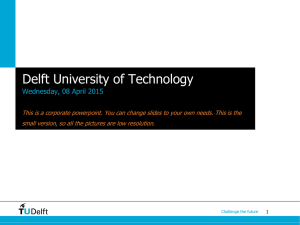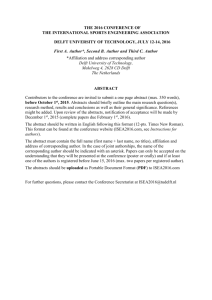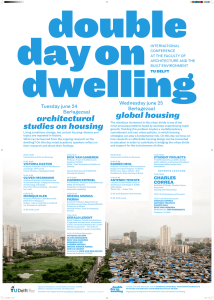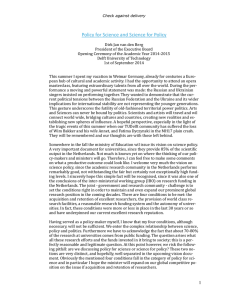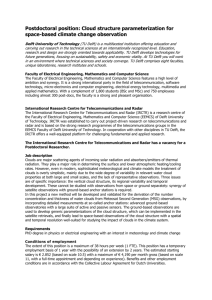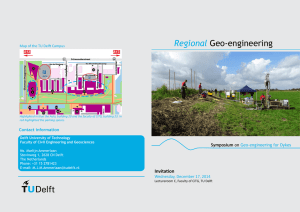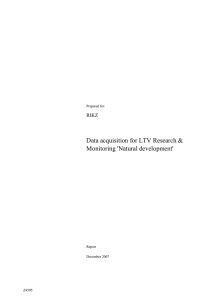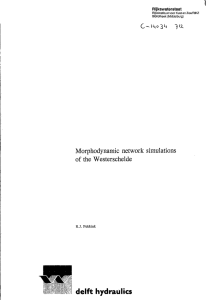engineering geology mapping
advertisement
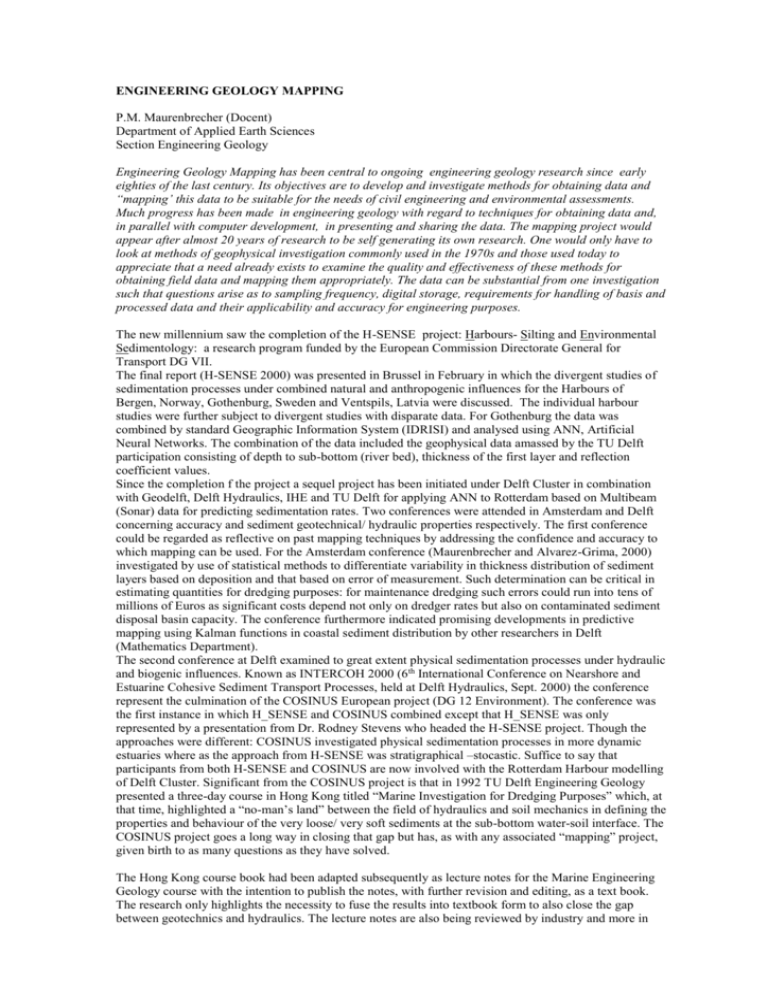
ENGINEERING GEOLOGY MAPPING P.M. Maurenbrecher (Docent) Department of Applied Earth Sciences Section Engineering Geology Engineering Geology Mapping has been central to ongoing engineering geology research since early eighties of the last century. Its objectives are to develop and investigate methods for obtaining data and “mapping’ this data to be suitable for the needs of civil engineering and environmental assessments. Much progress has been made in engineering geology with regard to techniques for obtaining data and, in parallel with computer development, in presenting and sharing the data. The mapping project would appear after almost 20 years of research to be self generating its own research. One would only have to look at methods of geophysical investigation commonly used in the 1970s and those used today to appreciate that a need already exists to examine the quality and effectiveness of these methods for obtaining field data and mapping them appropriately. The data can be substantial from one investigation such that questions arise as to sampling frequency, digital storage, requirements for handling of basis and processed data and their applicability and accuracy for engineering purposes. The new millennium saw the completion of the H-SENSE project: Harbours- Silting and Environmental Sedimentology: a research program funded by the European Commission Directorate General for Transport DG VII. The final report (H-SENSE 2000) was presented in Brussel in February in which the divergent studies of sedimentation processes under combined natural and anthropogenic influences for the Harbours of Bergen, Norway, Gothenburg, Sweden and Ventspils, Latvia were discussed. The individual harbour studies were further subject to divergent studies with disparate data. For Gothenburg the data was combined by standard Geographic Information System (IDRISI) and analysed using ANN, Artificial Neural Networks. The combination of the data included the geophysical data amassed by the TU Delft participation consisting of depth to sub-bottom (river bed), thickness of the first layer and reflection coefficient values. Since the completion f the project a sequel project has been initiated under Delft Cluster in combination with Geodelft, Delft Hydraulics, IHE and TU Delft for applying ANN to Rotterdam based on Multibeam (Sonar) data for predicting sedimentation rates. Two conferences were attended in Amsterdam and Delft concerning accuracy and sediment geotechnical/ hydraulic properties respectively. The first conference could be regarded as reflective on past mapping techniques by addressing the confidence and accuracy to which mapping can be used. For the Amsterdam conference (Maurenbrecher and Alvarez-Grima, 2000) investigated by use of statistical methods to differentiate variability in thickness distribution of sediment layers based on deposition and that based on error of measurement. Such determination can be critical in estimating quantities for dredging purposes: for maintenance dredging such errors could run into tens of millions of Euros as significant costs depend not only on dredger rates but also on contaminated sediment disposal basin capacity. The conference furthermore indicated promising developments in predictive mapping using Kalman functions in coastal sediment distribution by other researchers in Delft (Mathematics Department). The second conference at Delft examined to great extent physical sedimentation processes under hydraulic and biogenic influences. Known as INTERCOH 2000 (6 th International Conference on Nearshore and Estuarine Cohesive Sediment Transport Processes, held at Delft Hydraulics, Sept. 2000) the conference represent the culmination of the COSINUS European project (DG 12 Environment). The conference was the first instance in which H_SENSE and COSINUS combined except that H_SENSE was only represented by a presentation from Dr. Rodney Stevens who headed the H-SENSE project. Though the approaches were different: COSINUS investigated physical sedimentation processes in more dynamic estuaries where as the approach from H-SENSE was stratigraphical –stocastic. Suffice to say that participants from both H-SENSE and COSINUS are now involved with the Rotterdam Harbour modelling of Delft Cluster. Significant from the COSINUS project is that in 1992 TU Delft Engineering Geology presented a three-day course in Hong Kong titled “Marine Investigation for Dredging Purposes” which, at that time, highlighted a “no-man’s land” between the field of hydraulics and soil mechanics in defining the properties and behaviour of the very loose/ very soft sediments at the sub-bottom water-soil interface. The COSINUS project goes a long way in closing that gap but has, as with any associated “mapping” project, given birth to as many questions as they have solved. The Hong Kong course book had been adapted subsequently as lecture notes for the Marine Engineering Geology course with the intention to publish the notes, with further revision and editing, as a text book. The research only highlights the necessity to fuse the results into textbook form to also close the gap between geotechnics and hydraulics. The lecture notes are also being reviewed by industry and more in line with fashionable trendy subjects such as business administration and marketing or from genuine demands from industry, the content concerning logistics, contracts, project management and quality control has received favourable comment. It may be that the greater concerns of risk assessment, fraud, disputes, claims, environmental impact reporting, public hearings, feasibility studies and arbitration will have to receive more attention? The small research project carried out with Geoconsult (Haarlem) and the NAM looked at settlement rates previous to gas extraction in Friesland was completed. The essential results were published in paper and presented at a symposium held at Ravenna, Italy in an area of the Po Delta subject to not only gas extraction, shallow gas extraction, water extraction and natural consolidation (as evidenced by the very ancient 5th century churches). Stochastic cluster analyses was used to be able to obtain some insight to the meaning of the scarce and relatively old data one has to work with. Assigning the settlement velocities to membership groups (geological profiles) could reduce an element of speculation. Ideally one should search more factors to assign membership: foundation types of benchmarks, drainage histories and local geotechnical profiles (i.e. by cone penetration test). Such data would add to reducing further the speculative element of determining trends and help differentiate further what settlements and to what degree would be caused by gas extraction. It is this type of research that could be used as “evidence in court” with regards to claims for compensation or in environmental impact reports. Or is it as with the cancellation of the Wadden Sea development by the NAM under government pressure, that a well presented package based on carefully researched results will have little bearing on disputes? May be research should examine the science where not science but other logic which has little to do with scientific ethic (pseudo-demo science?) is more persuasive and leads to decisions. The Wadden Sea is not the only instance where science loses to legal machinations: badly formulated contracts can take precedence over science even in academia. In response to the two papers published in 2000 research should be aimed more at detection of errors, natural errors, un-intentional errors but also errors resulting from bad practice and malpractice, of which the latter can be regarded as fraudulent. Properties measured in geotechnics will remain within certain boundaries, they will also show a degree of scatter/ noise level. Part is due to nature and part is due to measurement. Seldom are these elements quantified in context of scientific quest for perfection and industries quest for translating into financial risk. What is acceptable and what is not acceptable in context of the purpose of using the data for engineering purposes; say a safe foundation and for science: proving a geological hypothesis? The time has come for more reflectivity. References Cheung, G., M.A. Alvarez Grima, P.M. Maurenbrecher, F. Schokking; Statistical analysis of benchmark stability prior to natural gas extraction in a Holocene clay and peat area, province of Friesland, The Netherlands. Proceedings of the 6th International Symposium on Land Subsidence, Ravenna, Italia, 2429 september 2000. Eds.: Carbognin, L.; G.Gambolati, A.I.Johnson, Padova, Italy. ISBN: 88-8722206-1. p. 237-254. (CA 2402). Maurenbrecher, P.M. and M. Alvarez Grima; Estimating error in geophysical sub-bottom profiling. In: Accuracy 2000. Proceedings of the 4th International Symposium on spatial accuracy in natural resources and environmental sciences. Amsterdam, The Netherlands, July 2000. Eds.: G.B.M. Heuvelink, M.J.P.M. Lemmens. p. 457- 464. Uitgever: Delft University Press. ISBN: 90-407-2085-1. (CA 2402). H-SENSE, 2000, Final Report: Harbours – Silting and Environmental Sedimentology, A Research Program funded by the European Commission Directorate General for Transport DG VII, October 2000 88p
